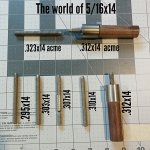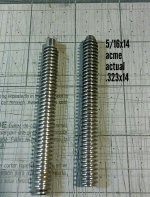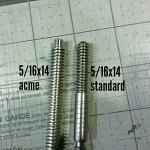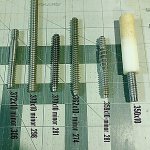I wouldn't. Esp on a Heubler w those nylon inserts. Can't imagine it would take much to cross thread one of those.Begs the question is it safe to force fit these joints?
You are using an out of date browser. It may not display this or other websites correctly.
You should upgrade or use an alternative browser.
You should upgrade or use an alternative browser.
5/16-18 joint mystery.
- Thread starter Mensabum
- Start date
You get what you 'play' for!! Lol.It seems that the Huebler shaft fits the Huebler butt snug. Ditto the Players shaft to the Huebler butt. The fit is fine and connecting the two is not forced.
It seems there is less slop in the connection between the Huebler shaft and Huebler butt than the Players shaft with the Players butt.
Would you need to match the type of thread?? Coarse, fine or extra fine, or would that matter??No, but it's easy enough to dress the threads of the shaft with a tap
Would you need to match the type of thread?? Coarse, fine or extra fine, or would that matter??
Run a 5/16-18 tap into a 5/16-18 shaft, it's all the same threads, just different minors
Just a standard tap??Run a 5/16-18 tap into a 5/16-18 shaft, it's all the same threads, just different minors
There are thread standards to ensure interoperability if threads are made at different shops. Most of the standards we use today were developed well over 100 years ago.
The form (shape) of the thread is designed for many different scenarios. A 60 deg V thread is general purpose. An acme thread is for higher forces and for motion. A buttress thread is for high forces in only one direction (like a clamp). A light bulb thread is for easy assembly so you don’t electrocute yourself standing on a ladder.
A machinist can make any of these threads to a standard. They can also customize them quite easily by adjusting the lathe as they cut the thread.
Coming back to pool, that’s exactly what several cue makers over the years did, in search of that elusive “hit”, and/or simply to have something unique.
How many players does it take to screw in that light bulb??There are thread standards to ensure interoperability if threads are made at different shops. Most of the standards we use today were developed well over 100 years ago.
The form (shape) of the thread is designed for many different scenarios. A 60 deg V thread is general purpose. An acme thread is for higher forces and for motion. A buttress thread is for high forces in only one direction (like a clamp). A light bulb thread is for easy assembly so you don’t electrocute yourself standing on a ladder.
A machinist can make any of these threads to a standard. They can also customize them quite easily by adjusting the lathe as they cut the thread.
Coming back to pool, that’s exactly what several cue makers over the years did, in search of that elusive “hit”, and/or simply to have something unique.
A Schon 5/16-14 is undersized major and minor. So, a Schon shaft won’t fit on a Joss, Tascarella or any 5/16-14 that is “full-size.”I've been lucky w my 14's so far.
I know you mentioned Acme. Anyone using an Acme thread for cue joint is nuts and I suspect have no idea what an Acme thread is. And no, Schon cues never used an Acme joint screw. Their pilot-nosed thread that Evan Clarke introduced into Schon cues in 1993 was not an Acme thread by any wild imagination. It was the same thread as all of Schon’s 5/16-14 joints.
It's a fairly well known fact that Schons don't fit Joss, Scruggs, etc...A Schon 5/16-14 is undersized major and minor. So, a Schon shaft won’t fit on a Joss, Tascarella or any 5/16-14 that is “full-size.”
I know you mentioned Acme. Anyone using an Acme thread for cue joint is nuts and I suspect have no idea what an Acme thread is. And no, Schon cues never used an Acme joint screw. Their pilot-nosed thread that Evan Clarke introduced into Schon cues in 1993 was not an Acme thread by any wild imagination. It was the same thread as all of Schon’s 5/16-14 joints.
Is it the thread or more the piloted end of the shaft that's different??
I know the ends of Schons shafts, the piloted portion, are shaped differently than Joss and other 5/16-14s. Personally, I've never tried to swap them. I've read comments on AZ where members have filed down that pilot so that they will fit a Joss, but why would you want to?? Lol. That's what I read anyhoo.
I mentioned Bill Stroud bcuz I read an article by him where he mentioned the Acme pins and how he was the first to incorporate them on a shaft. I don't think that went over too well or lasted very long either. Lol. We're talking decade ago, so... Garczar might know.
If they modified a Schon shaft to fit a Joss, they would turn down the outer diameter of the brass pilot, then put a regular tap into they insert.
Acme, entirely different situation.
Acme, entirely different situation.
Attachments
Holy crap!! I had no clue!!! Why so many?? I just don't get it.If they modified a Schon shaft to fit a Joss, they would turn down the outer diameter of the brass pilot, then put a regular tap into they insert.
Acme, entirely different situation.
Proprietary and all that is one thing, but surely those minor differences add more headaches than solutions.
Just goes to show how little I know of the cue making business.
These questions have bugged me for years. Thanks to all the members who helped clarify this matter for me!!
I finally got it.
Mad respect!!
It never ends. Individualism can be a pain the ass......Holy crap!! I had no clue!!! Why so many?? I just don't get it.
Proprietary and all that is one thing, but surely those minor differences add more headaches than solutions.
Just goes to show how little I know of the cue making business.
These questions have bugged me for years. Thanks to all the members who helped clarify this matter for me!!
I finally got it.
Mad respect!!
FOR OTHERS!
Attachments
Boy, you ain't kidding!!!It never ends. Individualism can be a pain the ass......
FOR OTHERS!
Here I thot I had this about nailed!!
Thanks Mike!! Solid.
Once the shaft and butt facings are completely tight against each other - I don’t feel a hit difference just bc the joint screw is not super tight when attaching the shaft.
Your tip hardness, ferrule type, shaft taper, cue joint material, and cue butt wood selection and construction will all be more influential factors on your cue playing characteristics , IMO.
Also - a cue shaft whose shaft collar diameter is slightly larger or smaller than the cue butt joint collar or a slightly undersized joint pin relative to the shaft thread does not really affect the cue - it is mostly in one’s mind. A overlap that one may feel just with a fingernail won’t affect your game unless you allow that to happen mentally.
Your tip hardness, ferrule type, shaft taper, cue joint material, and cue butt wood selection and construction will all be more influential factors on your cue playing characteristics , IMO.
Also - a cue shaft whose shaft collar diameter is slightly larger or smaller than the cue butt joint collar or a slightly undersized joint pin relative to the shaft thread does not really affect the cue - it is mostly in one’s mind. A overlap that one may feel just with a fingernail won’t affect your game unless you allow that to happen mentally.
Last edited:
I agree.Once the shaft and butt facings are completely tight against each other - I don’t feel a hit difference just bc the joint screw is not super tight when attaching the shaft.
Your tip hardness, ferrule type, shaft taper, cue joint material, and cue but wood selection and construction will all be more influential factors on your cue playing characteristics , IMO.
Also - a cue shaft whose shaft collar diameter is slightly larger or smaller than the cue butt joint collar or a slightly undersized joint pin relative to the shaft thread does not really affect the cue - it is mostly in one’s mind. A overlap that one may feel just with a fingernail won’t affect your game unless you allow that to happen mentally.
It's been my mission aka nightmare learning about the different joint screws for 30 years. I still don't know them all and new one's are still coming.Boy, you ain't kidding!!!
Here I thot I had this about nailed!!
Thanks Mike!! Solid.
Another new one that looks like the 5/16x18 is M8x1.25.
It's out there and looks very similar to Pechauer's quick release.
DeeDeeCues
Well-known member
It's been my mission aka nightmare learning about the different joint screws for 30 years. I still don't know them all and new one's are still coming.
Yep. Just like people poop every day, cue companies crap out 'advanced' joint pins every day.
Once the butt and shaft are tight on their joining faces, the only thing carried by the threaded member is tension.Once the shaft and butt facings are completely tight against each other - I don’t feel a hit difference just bc the joint screw is not super tight when attaching the shaft.
I was talking about a piloted nose on the joint thread not the pilot of the shaft insert into the butt. I think you’ve got confusion going on. The Schon is an undersized 5/16-14. That means the shaft thread is too small on the diameters vs the Joss and others.It's a fairly well known fact that Schons don't fit Joss, Scruggs, etc...
Is it the thread or more the piloted end of the shaft that's different??
I know the ends of Schons shafts, the piloted portion, are shaped differently than Joss and other 5/16-14s. Personally, I've never tried to swap them. I've read comments on AZ where members have filed down that pilot so that they will fit a Joss, but why would you want to?? Lol. That's what I read anyhoo.
I mentioned Bill Stroud bcuz I read an article by him where he mentioned the Acme pins and how he was the first to incorporate them on a shaft. I don't think that went over too well or lasted very long either. Lol. We're talking decade ago, so... Garczar might know.
if Bill Stroud actually was trying to put a true acme thread on a cue joint, I think he wasn’t thinking things through.. Bill was a great cue guy, and a pioneer. But he was no mechanical engineer. You can take that to the bank.
Last edited:



